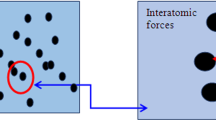Abstract
The nonequilibrium molecular dynamics (MD) method was used to model the nanocolloids and the solvent particles. By introducing a non-uniform electric field, colloids were polarized to have opposite polarities. Separation of colloids driven by dielectrophoresis (DEP) could be seen clearly under a strong electric field at low temperatures. Analyzing the ratio of DEP velocities of colloids to thermal velocities of neutral solvent particles showed that when the ratio was correspondingly big, collision between colloids and solvent particles would be intense, making the DEP velocity of colloids fluctuate frequently. By changing the electric field strength, it was found that the enhancement of electric field strength would quicken the separation of colloids. But when the electric field strength increased to a certain degree, the separation motion would be slow because of the strong friction resistance of the solvent particles to the colloids. Moreover, studying the separation reason of colloids based on the potential energy showed that after colloids were polarized, the attractive potential energy among the colloids would be weaker than before, while the increase of temperature would reduce the attractive potential energy and increase the repulsive potential energy, which accorded with the DLVO theory.
Similar content being viewed by others
References
Pohl H. Dielectrophoresis. New York: Cambridge University Press, 1978
Arnold W M, Zimmermann U. Electro-rotation-development of a technique for dielectric measurements on individual cells and particles. J Electrostat, 1988, 21(2): 151–191
Wang X B, Huang Y, Becker F F, et al. A unified theory of dielectrophoresis and traveling wave dielectrophoresis. J Phys D Appl Phys, 1994, 27(7): 1571–1574
Castellanos A, Ramos A, Gonzalez A, et al. Electrohydrodynamics and dielectrophoresis in micro-systems: scaling laws. J Phys D Appl Phys, 2003, 36(20): 2584–2597
Zheng L F, Li S D, Burk P J, et al. Towards single molecule manipulation with dielectrophoresis using nanoelectrodes. In: Proceedings of the 3rd IEEE Conference on Nanotechnology. SanFrancisco: IEEE, 2003, 1(12): 437–440
Zheng L F, Brody J B, Burke P J. Electronic manipulation of DNA, proteins, and nanoparticles for potential circuit assembly, Biosens. Bioelectron, 2004, 20(3): 606–619
Morgan H, Holmes D, Green N G. 3D focusing of nanoparticles in microfluidic channels. IEE Proc Nanobiotech, 2003, 150(2): 76–81
Li W H, Du H, Chen D F. et al. Analysis of dielectrophoretic electrode arrays for nanoparticle manipulation. Comp Mater Sci, 2004, 30(3–4): 320–325
Kim J E, Han C S. Use of dielectrophoresis in the fabrication of an atomic force microscope tip with a carbon nanotube: a numerical analysis. Nanotechnology, 2005, 16(10): 2245–2250
Tuukkanen S, Kuzyk A, Toppari J J, et al. Dielectrophoresis of nanoscale dsDNA and humidity effects on its electrical conductivity. Appl Phys Lett, 2005, 87: 183102
Jung J Y, Kwak H Y. Separation of microparticles and biological cells inside an evaporating droplet using dielectrophoresis. Anal Chem, 2007, 79(13): 5085–5092
Hermanson K D, Lumsdon S O, Williams J P. Dielectrophoretic assembly of electrically functional microwires from nanoparticle suspensions. Science, 2001, 294(5544): 1082–1086
Gray D S, Tan J L, Voldman J, et al. Dielectrophoretic registration of living cells to a microelectrode array. Biosens Bioelectron, 2004, 19(7): 771–780
Salonen E, Terama E, Vattulainen I, et al. Dielectrophoresis of nanocolloids: A molecular dynamics study. Europhys Lett, 2005, 18(2): 133–142
Salonen E, Terama E, Vattulainen I, et al. Enhanced dielectrophoresis of nanocolloids by dimmer formation. Europhys Lett, 2007, 78(4): 48004
Yuan L, Amberg G, Aldaeus F, et al. Simulation of dielectrophoretic motion of micro-particles using a molecular dynamics approach. In: Proceedings of ICNMM2006, Fourth International Conference on Nanochannel, Microchannels and Minichannels. Ireland: Limerick, 2006. 96095
Linse P, Lobaskin V. Electrostatic attraction and phase separation in solutions of like-charged colloidal particles. Phys Rev Lett, 1999, 83(20): 4208–4211
Tanaka M, Grosberg A Y. Electrophoresis of a charge-inverted macroion complex: Molecular dynamics study. Eur Phys J E, 2002, 7(4): 371–379
Laird B B, Skinner J L. Microscopic theory of reversible pressure broadening in hole-burning spectra of impurities in glasses. J Chem Phys, 1989, 90(6): 3274–3281
Chen Z Q, Wang G X, Xu G Y. Colloid and Interface Chemistry (in Chinese). Beijin: Higher Education Press, 2001. 150–193
Author information
Authors and Affiliations
Corresponding author
Additional information
Supported by the National Hi-Tech Research and Derelopment Program of China (“863” Project) (Grant No. 2006AA04Z351) and the National Natural Science Foundation of China (Grant Nos. 50675033, 30770553)
Rights and permissions
About this article
Cite this article
Ni, Z., Zhang, X. & Yi, H. Separation of nanocolloids driven by dielectrophoresis: A molecular dynamics simulation. Sci. China Ser. E-Technol. Sci. 52, 1874–1881 (2009). https://doi.org/10.1007/s11431-009-0089-1
Received:
Accepted:
Published:
Issue Date:
DOI: https://doi.org/10.1007/s11431-009-0089-1




